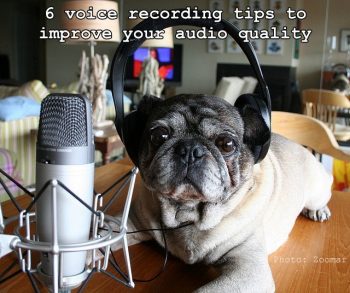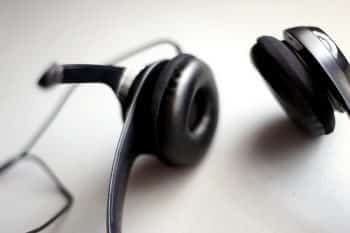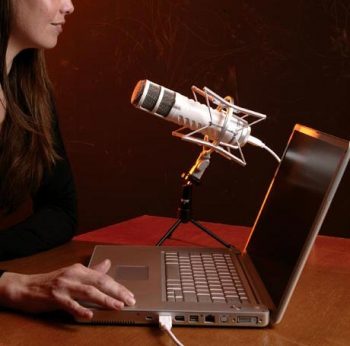 These days every man and his dog is doing it themselves.
These days every man and his dog is doing it themselves.
Podcasts, YouTube videos, PowerPoint Presentations and more. All made accessible to the everyday person (and pooch).
Technology is always getting cheaper and smaller, which is great.
But…
You knew there was a but didn’t you?
Without at least a basic understanding of what makes a good recording, and specifically voice over recording, you risk sabotaging all the effort you’ve made just by not applying some basic principles.
The more of these you use obviously the better your voice over recordings will sound but even one can be enough to make a big difference.
10 voice recording tips to improve your audio/video presentations
Here are the most important things you need do to get the most out of your voice recordings.
1. Reduce background noise
This is pretty obvious but something that’s easy to forget. If the room you’re in is next to a train line, for example, you will want to close the doors to the house. And if you’re in another room inside, close that door as well. If you’re really serious you can put up blankets at key places like windows to soak up more noise.
The ideal environment is a dedicated vocal booth like the ones that the Family Guy cast to use.
2. Invest in a decent microphone
They’re called transducers. Devices that convert one kind of signal to another. Microphones convert sound waves into tiny electrical impulses that travel down the wires and on to your recording device, usually a computer.
The first level of sound quality is the mic in your computer. It’s rubbish so stop using it for anything important.
The next level up is USB headset microphones.

These can be a great mid-price option with more than decent quality depending on how much you’re prepared to pay. Lifehacker published a good list of brands to look out for here: Five Best Headsets With Attached Microphones.
The next level of quality/price is a USB Podcasting Mic.
With the rise of Podcasting, there has been a whole range of USB Mics designed for this kind of home broadcasting. They’re generally good to high quality microphones that plug directly into your PC, bypassing the need for audio interfaces and pre-amps to boost the signal.
A great example is BlueMic.com with their famous Snowball.

And if you’re looking for a truly professional mic the Rode Podcaster would be well worth a look.

You can find a more extensive review of Podcasting mics here.
4. Speak up!
The softer the source volume, the more you have to turn up the pre-amp or boost the volume digitally which can make the signal weak and lacking in substance.
A strong source means a clearer end result in most cases. I’m not talking about yelling of course but a confident strong delivery means a cleaner signal with less intervention.
5. Get closer to the microphone
This is related to the previous point but it deserves it’s own section because it makes such a big difference. It’s called the proximity effect and describes the rise in bass response or warmth as you get closer to the microphone.
Every microphone responds differently so it’s worth experimenting a little bit to find the sweet spot. One way to find it is to start uncomfortably close to the mic and repeat “1,2,1,2” deep in your register while you move slowly away from it. You will notice a spot where the warmth of the response drops off dramatically.
Stay inside this range unless you want this thinner more open sound to the voice.
6. Use headphones
There’s a reason why the top voice over people use headphones even when they’re in a dead quiet room. It puts you more in touch with exactly what’s coming out of your mouth and in many cases increases the performer’s articulation without any formal training. This effect is more pronounced if the mic and the room have been paid attention to but I think you’ll still see a benefit without it.
The other thing headphones do is separate you from the outside world which usually narrows your focus and improves your performance.
Good brands of headphones to look out for: Sony, KRK, Sennheiser, Yamaha.
It’s about getting your message across
If you use all of these voice recording tips you’ll see a massive improvement in the quality of the spoken word quality on your videos or audio presentations and as a result you will connect more deeply with your audience.
What do you use your recordings for?
Share your audio project link in the comments, and I’ll have a listen!

Voice recording can be really tricky. There are things you should consider before starting your audio recording, like what settings and material needed. Thank you for sharing these tips.